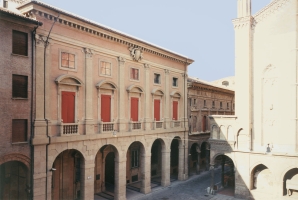
In Greco-Roman mythology, Aeneas was a Trojan hero, the son of the Trojan prince Anchises and the Greek goddess Aphrodite. His father was a first cousin of King Priam of Troy, making Aeneas a second cousin to Priam's children. He is a minor character in Greek mythology and is mentioned in Homer's Iliad. Aeneas receives full treatment in Roman mythology, most extensively in Virgil's Aeneid, where he is cast as an ancestor of Romulus and Remus. He became the first true hero of Rome. Snorri Sturluson identifies him with the Norse god Víðarr of the Æsir.

Niccolò dell'Abbate, sometimes Nicolò and Abate was a Mannerist Italian painter in fresco and oils. He was of the Emilian school, and was part of the team of artists called the School of Fontainebleau that introduced the Italian Renaissance to France. He may be found indexed under either "Niccolò" or "Abbate", though the former is more correct.

Francesco Albani or Albano was an Italian Baroque painter of Albanian origin who was active in Bologna, Rome, Viterbo (1609–1610), Mantua (1621–1622) and Florence (1633).

Palazzo Brera or Palazzo di Brera is a monumental palace in Milan, in Lombardy in northern Italy. It was a Jesuit college for two hundred years. It now houses several cultural institutions including the Accademia di Brera, the art academy of the city, and its gallery, the Pinacoteca di Brera; the Orto Botanico di Brera, a botanical garden; an observatory, the Osservatorio Astronomico di Brera; the Istituto Lombardo Accademia di Scienze e Lettere, a learned society; and an important library, the Biblioteca di Brera.

Palazzo Magnani is a Renaissance palace located on Via Zamboni number 20 in central Bologna, region of Emilia Romagna, Italy, built by the Magnani noble family with the same name.
In Greek mythology, the name Ilioneus may refer to:
Alfonso Torreggiani (1682–1764) was an Italian architect of the Rococo period, principally associated with Bologna.

The Palazzo Aldovrandi is a Senatorial palace on Via Galliera 8 in Bologna, built in Rococo style.

Domenico Pedrini was an Italian painter. Fiercely provincial in his geographic activity, Pedrini's works were mainly completed in and around Bologna, and yet his atavistic style strayed far afield into Bologna's strong Baroque ancestry.

The Palazzo Legnani Pizzardi, also known as Palazzo Pizzardi e Volta or just Palazzo Pizzardi, is a Renaissance style palace located on Via d'Azeglio #38, corner with Via Farini, in central Bologna, Italy. In 2015, the palace housed the Tribunal of Bologna.
Palazzo Zani is a Renaissance palace on via Santo Stefano 56 in central Bologna, region of Emilia Romagna, Italy.

The Palazzo Bonasoni is a Renaissance-style palace in Via Galliera 21 in central Bologna, Italy. It stands across the street from the Palazzo Felicini.

Palazzo Malvezzi Campeggi is a Renaissance palace located on Via Zamboni number 22, at the corner (southwest) with Via Marsala, in central Bologna, region of Emilia Romagna, Italy. It stands across from San Giacomo Maggiore, and just northeast of the Palazzo Magnani. It presently houses the law faculty of the University of Bologna.

Santa Lucia is a large, deconsecrated Roman Catholic church, located on Via Castiglione #36 in central Bologna. The building's brick facade was never completed; however, the Jesuits, owners of the church for over two centuries, decorated the interior with Baroque chapels, aligned along a spacious nave. For over a century, after suppression of the church, the building had multiple secular uses, as a barracks, warehouse, training workshop, and even a gym. But since a restoration in 1986-1986, the building has been used as the main assembly hall for the University of Bologna.

The Palazzo Torfanini is a Renaissance architecture palace located on Via Galliera 4, in central Bologna. It is located near the Palazzo Aldrovandi. The palace, with typical facade arcades, was commissioned by Bartolomeo Torfanini in 1544.

The Palazzo Caprara, also called Palazzo Galliera is a Renaissance-style urban palace located on Via IV Novembre #22 in central Bologna, region of Emilia-Romagna, Italy.
Girolamo Dal Pane or Dalpane was an Italian painter active in Bologna in a Neoclassical style.
Palazzo Spalletti-Trivelli is a palace located at Via Emilia A San Pietro #2, corner with Via San Nicolò, in the center of the city of Reggio Emilia, region of Emilia Romagna, Italy. The building now belongs to the Credito Emiliano (Credem) bank, and owns the art collection now in the palace.
The Palazzo Vizzani Lambertini Sanguinetti, sometimes known merely as Palazzo Vizzani, is a Renaissance palace located on Via Santo Stefano #43 in the center of Bologna, region of Emilia-Romagna, Italy. Presently the palace houses the faculty of Foreign Languages and Literature of the University of Bologna.

The Palazzo Fontanelli Sacrati, also known as the Palazzo Terrachini or Terracini or just Sacrati, is a Gothic and Renaissance-style palace with a main facade located on Via Emilia San Pietro #27 in the historic center of the town of Reggio Emilia, region of Emilia Romagna, in Italy. It is now used for private and cultural events.
Anton W.A. Boschloo, Il fregio dipinto a Bologna da Nicolò dell'Abate ai Carracci (1550-1580), Bologna, Nuova Alfa Editoriale, 1984, pp. 37–44, 82-83; Jan de Jong, "Locus plenus Troiani laboris". Gli affreschi di Enea a Palazzo Leoni a Bologna, in Studi Belgi e Olandesi per il IX centenario dell'Alma Mater Bolognese, Bologna, Edizioni Luigi Parma, 1990, pp. 35–48; Elisabetta Landi, Giuseppina Tonet, Libri a Palazzo. Una sede ritrovata per la Biblioteca dell'IBC, Bologna, Bononia University Press, 2011, pp. 188 (monograph on Palazzo Leoni)














